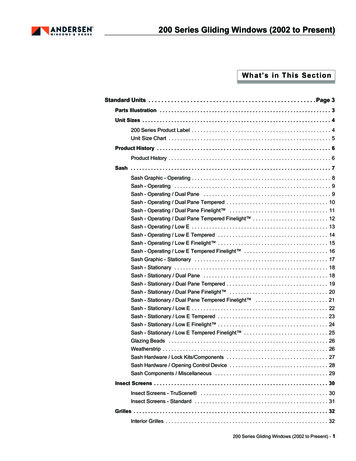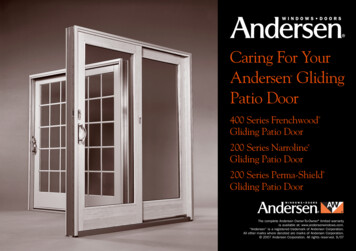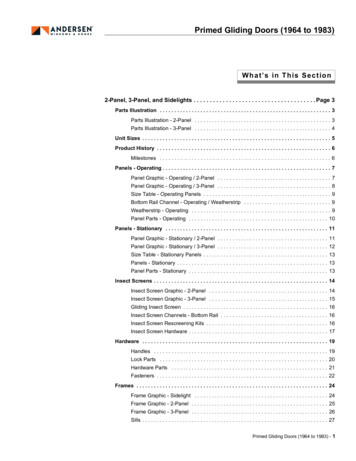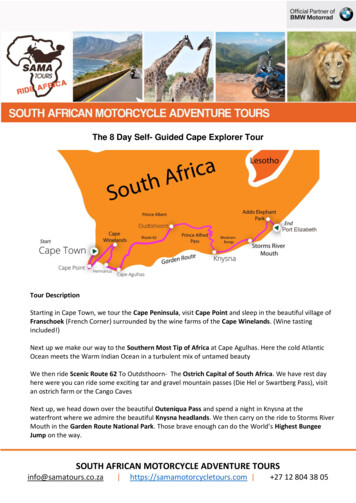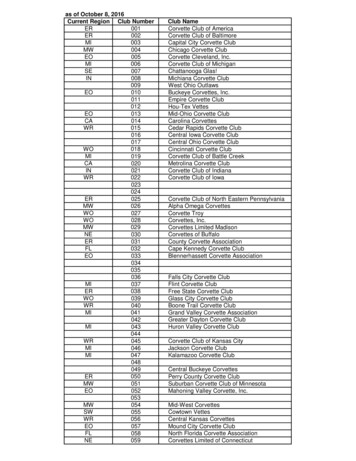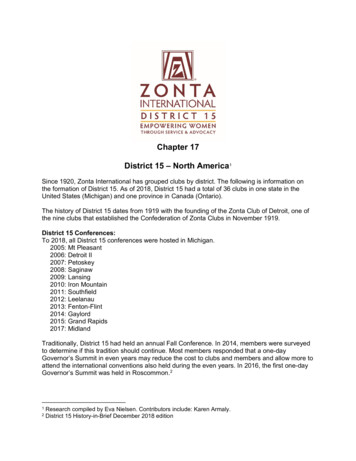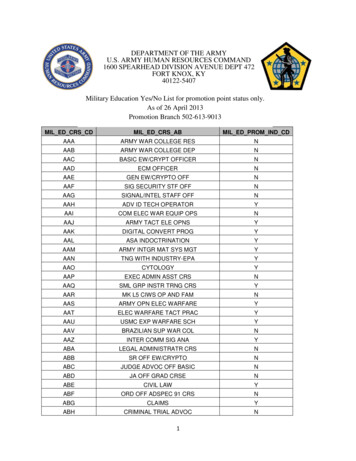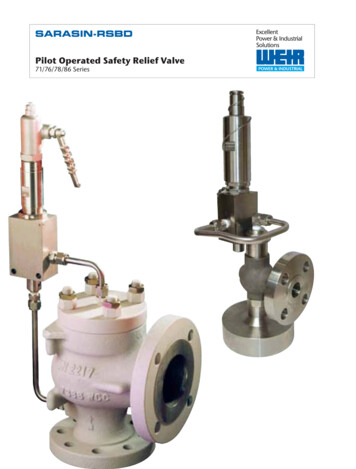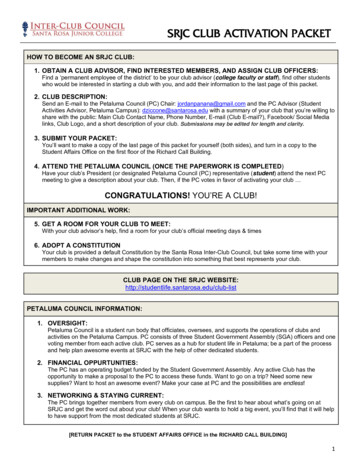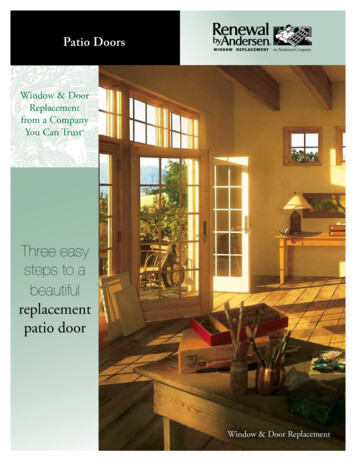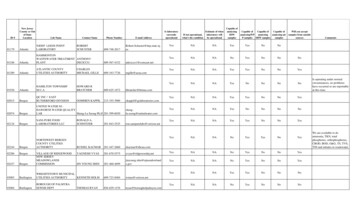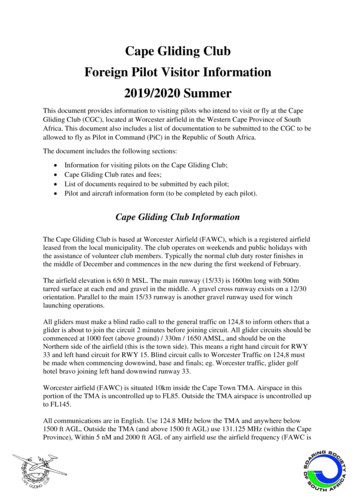
Transcription
Cape Gliding ClubForeign Pilot Visitor Information2019/2020 SummerThis document provides information to visiting pilots who intend to visit or fly at the CapeGliding Club (CGC), located at Worcester airfield in the Western Cape Province of SouthAfrica. This document also includes a list of documentation to be submitted to the CGC to beallowed to fly as Pilot in Command (PiC) in the Republic of South Africa.The document includes the following sections: Information for visiting pilots on the Cape Gliding Club;Cape Gliding Club rates and fees;List of documents required to be submitted by each pilot;Pilot and aircraft information form (to be completed by each pilot).Cape Gliding Club InformationThe Cape Gliding Club is based at Worcester Airfield (FAWC), which is a registered airfieldleased from the local municipality. The club operates on weekends and public holidays withthe assistance of volunteer club members. Typically the normal club duty roster finishes inthe middle of December and commences in the new during the first weekend of February.The airfield elevation is 650 ft MSL. The main runway (15/33) is 1600m long with 500mtarred surface at each end and gravel in the middle. A gravel cross runway exists on a 12/30orientation. Parallel to the main 15/33 runway is another gravel runway used for winchlaunching operations.All gliders must make a blind radio call to the general traffic on 124,8 to inform others that aglider is about to join the circuit 2 minutes before joining circuit. All glider circuits should becommenced at 1000 feet (above ground) / 330m / 1650 AMSL, and should be on theNorthern side of the airfield (this is the town side). This means a right hand circuit for RWY33 and left hand circuit for RWY 15. Blind circuit calls to Worcester Traffic on 124,8 mustbe made when commencing downwind, base and finals; eg. Worcester traffic, glider golfhotel bravo joining left hand downwind runway 33.Worcester airfield (FAWC) is situated 10km inside the Cape Town TMA. Airspace in thisportion of the TMA is uncontrolled up to FL85. Outside the TMA airspace is uncontrolled upto FL145.All communications are in English. Use 124.8 MHz below the TMA and anywhere below1500 ft AGL, Outside the TMA (and above 1500 ft AGL) use 131.125 MHz (within the CapeProvince), Within 5 nM and 2000 ft AGL of any airfield use the airfield frequency (FAWC is
124.8), monitor traffic and announce your own position and intention. Cape Town frequencyis 130.05. Chat frequency is 123.4 MHz. Before entering the active runway transmit that youare entering such.Flarm is compulsory and turnpoint and waypoint can be downloaded fromhttp://soaringweb.org/TP/WorcesterMost cross country flight is undertaken in thermal or ridge lift (or a combination), thoughconvergence and wave also occur. Due to the formation of mountain terrain in long lines,ridge lift is common at any time of year, though its occurrence depends on the direction of thewind relative to the terrain. Winds are generally from the South East (a shallow, low-levelwind) or North West (a wind which extends to great height), and both produce ridge lift.Northerly winds also produce lee-wave conditions. Thermal conditions can occur at any timeof year, with any wind, but mainly between spring (September) and autumn (April). Thermalconditions are best on post-frontal days. Convergence in the Worcester valley can occurduring weather and wind changes and this lift is generally formed in lines through the valley.Worcester is located in a water scarce area and has undergone severe drought in the previousyears. Water ballast may be used sparingly and it is advisable to try and recycle as much aspossible. This may change if water restrictions are imposed as a result of a draught.All visiting pilots are warned that the local Worcester/ Robertson / Wolseley area is a VINE farmingregion, which limits the outlanding optionssignificantly. Open areas are often covered withscrub and the terrain is very rocky. Eastward atSwellendam and northward at Tulbach, the vinesgive way to wheat, where outlanding options aremore plentiful. NEVER land in a vineyard, bushcovered field or rocky area.Visitors may camp at the airfield, where ablution facilities and a swimming pool areavailable. Visitors may also use the Cape Gliding Club huts on the airfield. We have two hutsavailable: a club bunkhouse hut which has 6 beds and a small kitchenette and space forvisitors to store their clothes, and a luxury hut for two people, which includes a kitchen,lounge, shower and toilet. Private hut owners may also rent their huts to visitors.The following briefings must be provided to each visiting pilot by the Cape Gliding ClubChief Flying Instructor (CFI) prior to first flight: FAWC local procedures briefing (launching, circuit, ground procedures, etc.)Radio procedures briefingLocal airspace briefingLocal weather briefingOutlanding briefingSouth African Air LawCheck flight with instructor (optional)
Joining Cape Gliding Club & Documentation RequirementsVisitors are required to be temporary members (valid for three months) of the SoaringSociety of South Africa (SSSA) and Cape Gliding Club. The SSSA is the relevant AviationRecreation Organisation (ARO), in terms of part 94 of the South African Civil AviationRegulations 2011, which is legally allowed to oversee all gliding activities in South Africa.Each pilot must join the Cape Gliding Club by completing the Online MembershipForm on the myGlidingClub website: bership-formAfter joining the club using myGlidingClub, then each person must submit certaindocuments, depending on what glider you will be flying (i.e. either German on South Africanglider).If you will be flying a German glider with a German license or any other UE-FCL licence,then you need to upload the following documents to myGlidingClub:1. Copy of Glider Pilot License or Student Pilot License issued by NAC or Aeroclub;2. Copy of valid medical certificate (Class 4 or higher);3. Copies of last 4 pages of gliding logbook;4. Copy of passport;5. Pilot and aircraft information form (filled out page 5 of the attached document);6. Cape Gliding Club Indemnity Form (filled out page 6 of the attached document); and7. Proof of 3rd party insurance for each aircraft.If you will be flying a RSA registered glider or aircraft (ZS, ZU or ZT) glider with a Germanlicence, then you need to apply for a 28-day validation of your foreign glider pilot license(i.e. any non South African license):1) Complete attached CA61.01.15 application form. If you will be flying more than 28 daysyou need to fill in 2 applications forms. Please make sure you comply with requirementsnumbers 2, 5 and 6 listed in the form.2) Certify all documents.3) Scan and email your completed application and supporting documentsto nicky@pointacad.com no later than 60 days prior to the date of your first flight. Nicky willthen forward your application to South African Civil Aviation Authority (SACAA), who willverify with your authority (e.g. LBA) to make sure all the documentation is valid and toconfirm your license validity.4) After you have sent Nicky your scanned copies, then you need to mail the originaldocuments to Nicky via DHL with a tracking number. Please send to: Nicky Oberhofer, 10General Chris Muller Crescent, Welgelegen, CapeTown, 7500, South Africa5) After arriving in SA, do a competency flight check and receive a briefing covering localradio procedures, Air Law aspects, airspace and density altitude (will be done by one of ourinstructors prior to your first flight).
Cape Gliding Club RatesThe following fees are applicable for the 2019/20 Summer Season and will be payable to theCape Gliding Club:DescriptionSSSAMembershipCGCAirfield rSoaring Society of South Africa temporarymembership (once off)Cape Gliding Club Visiting Glider Pilot TemporaryMembership per month (or part thereof)Airfield Usage charge per glider per dayFacilities usage charge per day per person (nonstudent)Facilities usage charge per day per person (student)Club bunkhouse hut per day (up to 6 pax)Club luxury hut per day (2 pax max, includes akitchen, lounge, shower and toilet)Aerotow launch per minute (minimum charge 10minutes)Per glider per launch (this rate applies to visitors andCGC members on days when there is no CGC tugpilot on duty, as part of normal club duty roster)Club glider rental per minute2019EURRate 45.00 15.00 19.25 9.90 4.95 3.85 19.25 3.85 7.00 0.30The prices above includes South African tax (VAT) of 15%.The Cape Gliding Club will issue a tax invoice upon completion of your visit. Invoices mustbe paid in South African Rand (ZAR) within 30 days and will be subject to the Euro Randexchange rate on the date of payment.CGC Payment Details:Bank: ABSA Bank LimitedAccount Name: Cape Gliding ClubAccount Number: 1219500609Swift code: ABSAZAJJ - (add CCT if more digits required)Sort code: ZA632005Account Type: Current/Cheque AccountIBAN: ZA6320051219500609 – (NOT USED IN SOUTH AFRICA)
Pilot and Aircraft Information FormPilot InformationName:Nationality:Gliding Club:FAI Competitors License OR GPL number:Expiry date / renewal date of license:Contact DetailsEmail:Mobile:In case of emergency contact:Contact details:Any relevant medical conditions / allergies:Aircraft InformationGlider Type: Registration Number:Contest/Tail Number: Authority to Fly expiry date:I, , hereby undertake to fly according to the rules andprocedures in place at Cape Gliding Club, operating out of Worcester Airfield (FAWC). Ialso understand that the expiry of my foreign license validation is 90 days from the approvaldate below or upon the expiry of my foreign license, whichever comes first.Signed at (place) on (date)Signature:APPROVED BY: SIGNATURE: DATE:
Cape Gliding Club Indemnity Form1. I, the undersigned irrevocably indemnify the SoaringSociety of South Africa, the Aero Club of South Africa, Cape Gliding Club and its agentsfrom any claim I, my heirs or estate may have arising out of any injury to myself or caused bymyself or my death as a result of flying from or using the facilities provided at FAWC.2. I declare that I comply with all the legal and currency requirements for piloting a glider inmy country of origin and in South Africa.3. I declare that my glider (registration and call signconforms to all airworthiness requirements.4. The glider is insured by for Third Party cover to the value ofSigned at (place) on (date)Signature:Witness 1:Signature:Witness 2:Signature:
Chief Flying Instructor (CFI) prior to first flight: FAWC local procedures briefing (launching, circuit, ground procedures, etc.) Radio procedures briefing Local airspace briefing Local weather briefing Outlanding briefing South African Air Law Check flight with instructor (optional)
